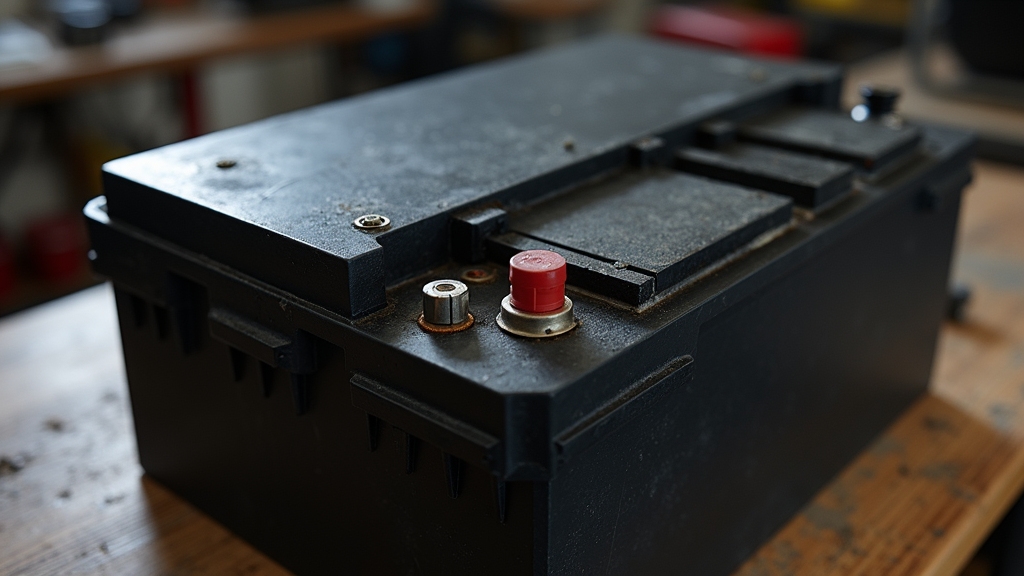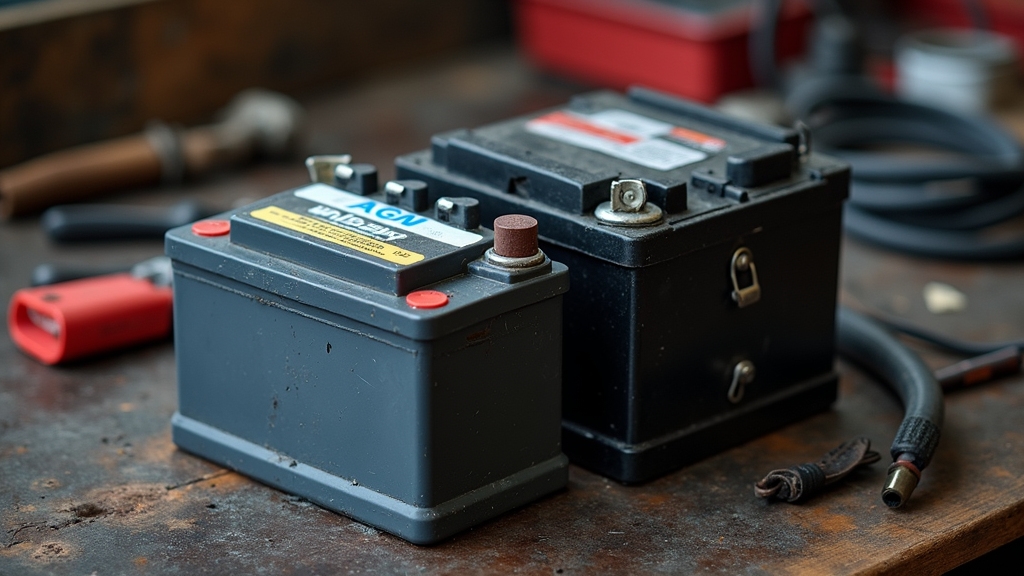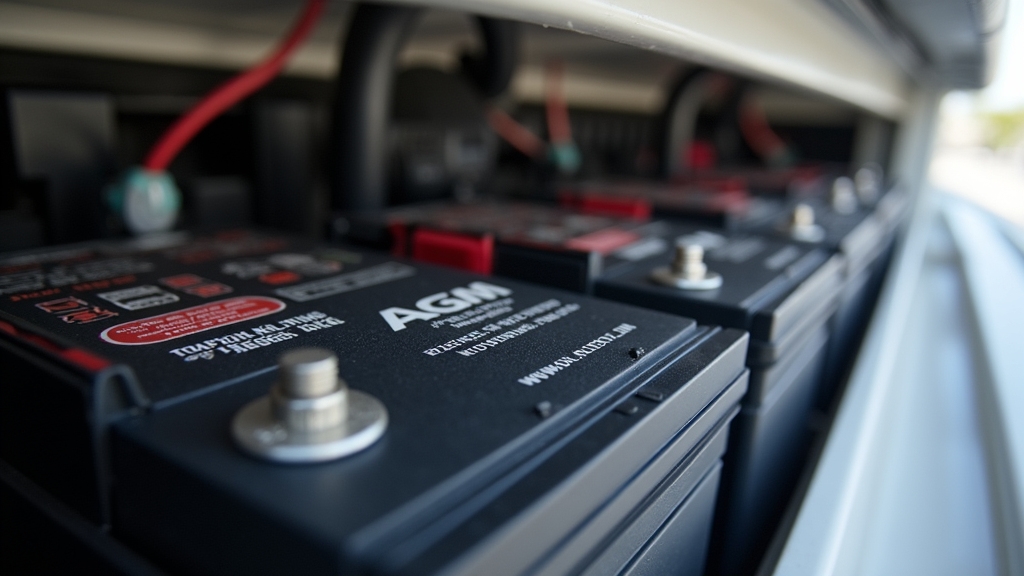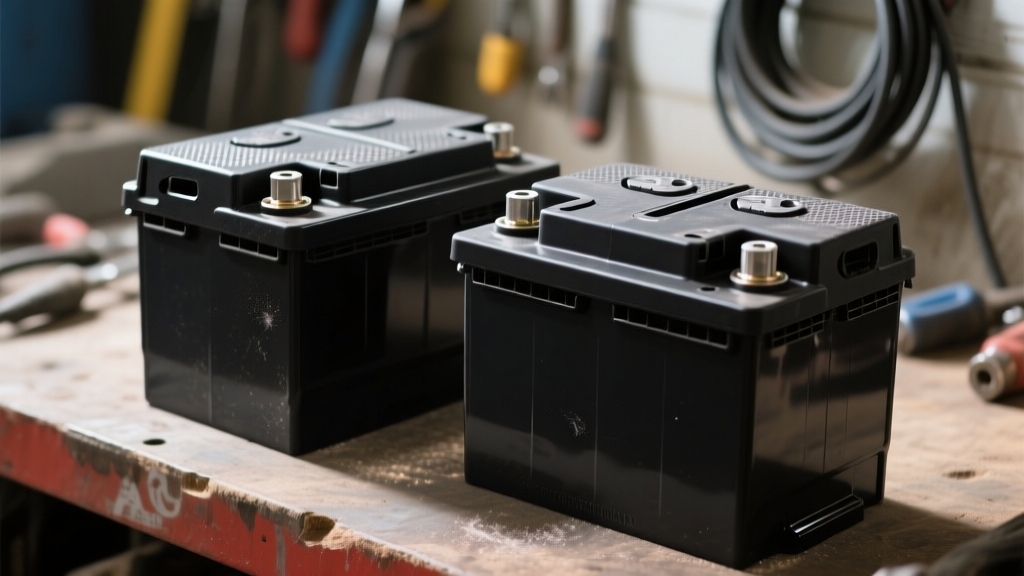You don’t need to vent AGM batteries during normal use because their sealed design recombines most gases internally. They only release excess pressure through built-in relief valves. These valves open only under high pressure to prevent damage, so routine venting isn’t necessary.
However, proper installation with passive ventilation helps manage any minor gas release and heat buildup. Understanding the battery’s internal processes and safety considerations can clarify why venting requirements differ from traditional flooded batteries.
Key Takeaways
- AGM batteries are sealed and typically do not require routine external venting under normal operation.
- Internal gas recombination minimizes hydrogen and oxygen release, maintaining a spill-proof, maintenance-free design.
- Safety valves open only under excessive pressure to release gases and prevent case rupture, then reseal automatically.
- Vent tubes may be used to safely direct occasional gas emissions outside enclosed spaces for safety.
- Proper ventilation and unobstructed venting prevent hydrogen buildup and reduce explosion risks during overcharging or damage.
Understanding AGM Battery Design and Venting Mechanisms

How do AGM batteries manage internal gases without external venting? They use a sealed, valve-regulated design that controls internal pressure through pressure relief valves. This design is similar to how sealants extend the lifespan of wood surfaces by protecting against environmental damage.
These valves release minor gas buildup during charging, preventing dangerous pressure accumulation without the need for continuous external venting. However, in certain applications such as vehicles or boats, additional venting requirements may be necessary to safely dissipate hydrogen gas.
Valves safely release minor gas buildup during charging, avoiding dangerous pressure without constant external venting.
The internal construction immobilizes electrolyte in fiberglass mats, reducing electrolyte stratification and water loss while allowing oxygen to recombine internally.
Valve relief vents only open under excessive pressure, safeguarding the battery casing from damage or rupture. This sealed setup makes AGM batteries maintenance-free and spill-proof, avoiding electrolyte leakage risks common in flooded batteries.
Although designed to operate without external venting, these mechanisms ensure safe gas management under normal conditions by balancing internal pressure and preventing hazardous gas release.
Internal Gas Recombination Process in AGM Batteries
When you charge or discharge an AGM battery, gas is generated due to the electrochemical reactions happening inside the cells. It’s pretty fascinating! This gas doesn’t just sit around; it actually goes through an internal recombination process. Here’s how it works: oxygen reacts with hydrogen to form water.
This reaction helps reduce water loss and keeps the electrolyte balance stable. The glass mat separator saturated with electrolyte is a core component that ensures efficient ion flow during charge/discharge. Proper maintenance and monitoring can further enhance battery life and safety, similar to how regular upkeep benefits RV air conditioners.
Now, about safety—there’s a valve pressure relief system in place. It only kicks in if the internal pressure exceeds safe limits. This means you can operate the battery without worrying about frequent venting, which is a great feature for ensuring safe operation!
Gas Generation Mechanism
Although charging AGM batteries inevitably produces gases through water electrolysis, the internal gas recombination process efficiently manages this generation to maintain battery integrity.
During charging, water in the electrolyte splits into hydrogen at the negative plates and oxygen at the positive plates. The AGM design, with electrolyte absorbed in the glass mat, limits free liquid and gas bubble formation, contributing to its load capacity efficiency.
Oxygen diffuses to the negative plate, where it chemically recombines with lead compounds to reform water. This process markedly reduces net gas buildup and water loss, contributing to the battery’s low self-discharge. This sealed system prevents gas escape unless pressure thresholds are exceeded.
The AGM separator also facilitates uniform electrolyte distribution and oxygen transport, enhancing recombination efficiency. Consequently, AGM batteries minimize venting, sustain maintenance-free operation, and protect internal components from corrosion caused by oxygen exposure.
Recombination Chemistry Explained
Because AGM batteries generate hydrogen and oxygen gases during charging, they rely on an internal recombination process to convert these gases back into water.
Oxygen produced at the positive plate migrates through the absorbent glass mat separator to the negative plate, where it recombines with hydrogen, forming water and minimizing electrolyte loss.
This absorbent glass mat immobilizes the electrolyte while facilitating gas transport, enabling efficient recombination. The sealed construction also makes AGM batteries spill-proof and vibration-resistant, suitable for a variety of demanding applications.
The process considerably reduces water loss, up to 98% compared to conventional batteries, eliminating the need for electrolyte topping and making AGM batteries largely maintenance-free. Proper maintenance and inspection ensure the battery performs reliably over time by preventing issues related to component degradation.
By controlling internal gas generation and recombination, AGM batteries maintain sealed construction, improve safety by limiting hydrogen emissions, and support longer cycle life through reduced degradation.
Valve Pressure Relief
The internal recombination process in AGM batteries considerably limits gas buildup. However, under certain conditions, excess pressure can still develop.
AGM batteries include a pressure relief valve that opens only if internal pressure surpasses safe limits. This is usually caused by overcharging or malfunction. The valve prevents case rupture by venting excess gas and then reseals to maintain the sealed environment.
The valve is a critical component of the battery’s sealed structure, which prevents electrolyte leakage and allows various installation orientations. Proper maintenance and monitoring can extend the battery’s lifespan and performance.
During normal operation, the valve remains closed, allowing efficient oxygen recombination and minimizing electrolyte loss.
Key points about valve pressure relief:
- The valve activates only when gas generation exceeds recombination capacity.
- Venting is rare and indicates potential charging or battery issues.
- Proper valve function ensures safety by preventing dangerous pressure buildup while preserving sealed conditions.
The Role of Pressure Relief Valves in AGM Batteries
How do pressure relief valves guarantee the safe operation of AGM batteries? These one-way valves release excess internal pressure caused by gas buildup during overcharge, preventing case rupture or deformation. This valve-regulated feature is essential for maintaining the battery’s overall safety and efficiency. They are a key component in ensuring the battery can withstand extreme conditions without failure.
They maintain the battery’s sealed environment by allowing hydrogen and oxygen to escape without letting air enter, avoiding contamination.
Integral to gas recombinant technology, they support the oxygen recombination cycle by preserving slight internal pressure, which suppresses hydrogen production and reduces water loss.
The valves remain closed under normal conditions, opening only when safety thresholds are exceeded. Constructed from corrosion-resistant materials, they ensure durability and maintenance-free operation.
Differences in Venting Between AGM and Flooded Lead-Acid Batteries

Although AGM and flooded lead-acid batteries share similar electrochemical principles, their venting requirements differ markedly due to design variations.
AGM batteries are sealed units that minimize gas emission through internal recombination, so they generally don’t require external venting. Flooded batteries, however, generate significant hydrogen gas during charging, necessitating dedicated venting systems to safely release this gas.
The importance of durability in battery design ensures that these systems operate safely under various environmental conditions.
While AGM batteries may have vent tubes, these are primarily for installation flexibility, not gas evacuation. Vent tubes also provide a secure location for vent lines when converting or installing sealed batteries in aircraft systems.
Key differences include:
- AGM Batteries: Sealed design, minimal outgassing, no external venting needed, but require space for heat dissipation.
- Flooded Batteries: Open design, produce hydrogen gas, need vent tubes connected to external ventilation.
- Safety: Proper venting is critical for flooded batteries to avoid gas accumulation hazards.
Safety Concerns Related to Hydrogen Gas Release
Understanding the venting differences between AGM and flooded lead-acid batteries highlights important safety considerations related to hydrogen gas release.
While AGM batteries generate hydrogen gas at lower levels, overcharging or physical damage can trigger the safety relief valve to release flammable hydrogen. This creates an explosive air-gas mixture.
You must avoid ignition sources near these batteries, as sparks or flames can ignite hydrogen, causing fires or blasts that disperse corrosive electrolyte and battery fragments. Confined or poorly ventilated spaces increase these risks considerably.
Additionally, exposure to battery gases, including toxic arsine formed under certain conditions, poses serious health hazards.
Health risks include respiratory irritation and chemical burns. Strict adherence to manufacturer charging guidelines and use of protective equipment during handling are essential to mitigate these dangers effectively.
For extended service life and safety, AGM batteries benefit from their low maintenance design compared to flooded lead-acid batteries.
Proper Ventilation Requirements for AGM Battery Compartments

Since AGM batteries produce minimal gas under normal conditions, you might assume ventilation isn’t necessary. However, proper ventilation in battery compartments remains essential to prevent hazardous gas buildup, especially during overcharging or in confined spaces. Batteries release gases during charge/discharge cycles, making proper venting critical for safety. Selecting compatible materials for vent components helps ensure long-term durability and resistance to corrosion.
AGM batteries equipped with vent holes require routing these vents outside enclosed areas to avoid gas accumulation. In campervans or similar habitats, directing any released gases outdoors ensures occupant safety.
Additionally, maintaining adequate airflow reduces the risk of pressure buildup and potential hazards.
Key ventilation requirements include:
- Installing dedicated vent tubes to channel gases safely outside.
- Ensuring vent holes remain unobstructed and appropriately sized.
- Using corrosion-resistant materials for vent system components to maintain integrity.
Following these guidelines ensures a safe, compliant AGM battery installation even in confined or inhabited spaces.
Effects of Heat and Ventilation on AGM Battery Performance
Proper ventilation prevents gas buildup and helps regulate the temperature around AGM batteries. This regulation directly impacts their performance and lifespan. Elevated heat accelerates chemical reactions and plate corrosion, which reduces capacity and increases self-discharge rates.
Without adequate ventilation, batteries face thermal runaway risks and premature failure. Maintaining batteries within the recommended temperature range is crucial to prevent accelerated internal wear and extend cycle life through controlled temperature management.
Additionally, maintaining optimal conditions is similar to how enzyme-based formulations in RV treatments enhance system longevity by preventing buildup.
| Effect | Impact |
|---|---|
| High Temperature (>25°C) | Decreases efficiency and lifespan |
| Elevated Chemical Reaction | Increases plate corrosion and sulfation |
| Insufficient Ventilation | Raises thermal runaway and fire risks |
| Overcharging in Heat | Causes electrolyte drying and damage |
To maintain ideal function, ensure proper airflow to dissipate heat and support temperature-compensated charging. This will help preserve battery integrity and safety.
Installation Best Practices to Manage Gas and Heat
When you’re installing AGM batteries, it’s super important to make sure that the battery compartment has good ventilation. This helps to prevent any gas from building up during those rare moments when the vent valve releases.
Proper venting is essential to allow hydrogen vapor escape, even though AGM batteries produce minimal gas under normal operation.
Also, think about incorporating some heat dissipation strategies. Giving the batteries enough clearance and using heat-resistant materials can really help keep those operating temperatures in check.
Battery Compartment Ventilation
How do you guarantee safe operation and longevity of AGM batteries within confined spaces? Proper battery compartment ventilation is key.
AGM batteries, while maintenance-free, can emit hydrogen gas during overcharging. You must ensure venting systems direct gases outside to prevent hazardous buildup. Battery compartments should have vent openings with a minimum area of 1.7 square inches within 2 inches of the top and bottom to meet safety standards.
Install vents near the compartment bottom to allow gas escape and fresh air intake. Use corrosion-resistant materials for durability and inspect vents regularly for blockages or damage.
Key ventilation practices include:
Providing at least 1.7 square inches of vent openings within 2 inches of both compartment sides. Use vent tubes for pressure release when applicable. Position vents to minimize ignition risks and facilitate airflow.
Following these guidelines guarantees safe, efficient battery operation and compliance with safety standards.
Heat Dissipation Strategies
Beyond ensuring adequate ventilation to manage hydrogen gas, you need to address heat dissipation effectively to maintain AGM battery performance and longevity.
Modern AGM battery systems increasingly integrate advanced thermal management to prevent localized hot spots and thermal runaway. Use heat-conductive materials and design battery casings with cooling channels or fins to enhance thermal management.
Install batteries in shaded, ventilated enclosures with natural airflow, avoiding tight spaces that trap heat. Employ smart chargers with temperature compensation and schedule charging during cooler periods to minimize thermal stress.
| Strategy | Implementation | Benefit |
|---|---|---|
| Heat-conductive design | Graphene composites, heat sinks | Improved internal/external heat transfer |
| Cooling systems | Forced air, liquid cooling | Active temperature regulation |
| Installation location | Shaded, ventilated enclosures | Reduced heat accumulation |
| Charging control | Temperature-compensated chargers | Avoids overheating |
| Thermal monitoring | Sensors and algorithms | Early heat rise detection |
Maintenance and Monitoring to Prevent Overcharging Risks
Although AGM batteries are designed for durability, diligent maintenance and monitoring are essential to prevent overcharging risks that can lead to premature failure.
Proper care and vigilance are vital to avoid overcharging and extend AGM battery life.
You should use a smart charger specifically designed for AGM batteries and set the charge voltage strictly between 14.4 and 14.6 volts to avoid excessive voltage.
Regularly inspect terminals for corrosion and ensure connections are secure to maintain efficient charging.
Monitoring battery voltage during charging and storage helps you detect early signs of overcharging or abnormal heat buildup. It is also important to avoid discharging AGM batteries below 50% to maximize lifespan.
Key practices include:
- Employ temperature-compensated chargers and avoid charging outside 0°C–45°C to reduce thermal risks.
- Use battery management systems with automatic shutoff to prevent voltage spikes.
- Recharge batteries after each cycle to at least 80% state of charge to minimize sulfation and capacity degradation.
These steps safeguard battery longevity and performance.
Common Misconceptions About AGM Battery Venting
Maintaining correct charging parameters helps minimize risks associated with AGM batteries, but understanding their venting behavior is equally important. AGM batteries are a type of VRLA battery that uses an absorbent glass mat separator to hold electrolyte in place, making them spill-proof and maintenance-free.
You might think AGM batteries never vent because they’re labeled “maintenance-free,” but that term means no water topping—not zero gas production.
AGM batteries produce hydrogen during charging, especially if overcharged. Their sealed design includes a pressure-relief valve that opens only if internal pressure exceeds safe limits, releasing hydrogen safely.
You shouldn’t assume AGM batteries are completely gas-tight or install them in airtight compartments.
Unlike flooded batteries needing active venting, AGM units require only adequate space for heat dissipation and passive ventilation to prevent gas buildup.
Following manufacturer guidelines for ventilation and avoiding overcharging ensures safe operation without unnecessary external venting systems. Proper installation avoids the need for external ventilation.
Frequently Asked Questions
Can AGM Batteries Be Installed Upside Down Without Leaking?
You can install AGM batteries upside down without electrolyte leakage because their design immobilizes the electrolyte in a glass mat.
However, you shouldn’t assume this is always safe. The internal pressure relief vent may not function properly when inverted, risking gas buildup and potential damage.
Always check the manufacturer’s guidelines before mounting upside down.
If you must, monitor the battery closely to prevent venting issues or safety hazards.
How Do Ambient Temperature Fluctuations Affect AGM Battery Lifespan?
Ambient temperature fluctuations considerably impact your AGM battery’s lifespan. High temperatures above 25°C accelerate chemical degradation, halving lifespan every 8°C rise.
Cold slows degradation but stresses the electrolyte physically. Continuous exposure above 38°C can reduce life drastically, whereas freezing temperatures lower capacity and performance.
To maximize lifespan, maintain your battery near 20–25°C, avoid extreme heat or cold, and use thermal management like insulation or heaters.
Are AGM Batteries Suitable for Underwater or Marine Applications?
Yes, AGM batteries are ideal for marine applications.
You’ll benefit from their sealed, spill-proof design that prevents electrolyte leaks and reduces gas emission, making them safe even in confined spaces like bilges.
Their superior vibration resistance and corrosion protection handle harsh saltwater environments well.
Plus, AGM batteries offer deep cycling capabilities and reliable performance, ensuring your boat’s electronics and engine start smoothly without frequent maintenance or venting concerns.
What Is the Typical Lifespan Expectancy of an AGM Battery?
You can expect an AGM battery to last around 4 to 7 years with proper care, which is roughly 2 to 3 times longer than traditional flooded lead-acid batteries.
Its lifespan hinges on factors like driving habits, climate, and charging quality. Regular long drives and well-maintained charging systems extend its life, while extreme temperatures and deep discharges shorten it.
High-quality AGM batteries may even reach up to 10 years under ideal conditions.
Can AGM Batteries Be Safely Used in Cold Climates Without Special Precautions?
You can safely use AGM batteries in cold climates without special ventilation, thanks to their minimal gassing and sealed design.
However, you should maintain regular charging and avoid deep discharges to preserve performance, as extreme cold still reduces available power.
Storing your battery in sheltered conditions and using a battery maintainer during inactivity will help prevent voltage drops and sulfation, ensuring reliable starts and longer lifespan in freezing temperatures.
Built for Safety: Inside the AGM Battery’s Venting System
While AGM batteries are designed to quietly handle gas internally, they’re not completely sealed vaults. You’ll want to make certain they have a thoughtful environment, allowing any subtle pressure to find its way out safely.
Proper installation and ventilation act like a gentle handshake, maintaining performance and extending battery life. By understanding these nuances, you’ll avoid surprises and keep your system running smoothly, turning potential risks into manageable, almost invisible details.



